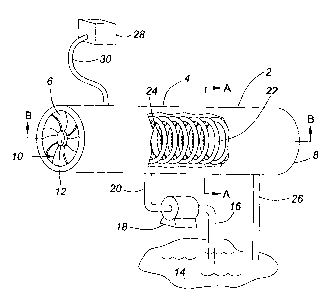Some of the information on this Web page has been provided by external sources. The Government of Canada is not responsible for the accuracy, reliability or currency of the information supplied by external sources. Users wishing to rely upon this information should consult directly with the source of the information. Content provided by external sources is not subject to official languages, privacy and accessibility requirements.
Any discrepancies in the text and image of the Claims and Abstract are due to differing posting times. Text of the Claims and Abstract are posted:
| (12) Patent Application: | (11) CA 2726568 |
|---|---|
| (54) English Title: | OUTDOOR AIR PURIFIER |
| (54) French Title: | PURIFICATEUR D'AIR D'EXTERIEUR |
| Status: | Deemed Abandoned and Beyond the Period of Reinstatement - Pending Response to Notice of Disregarded Communication |
| (51) International Patent Classification (IPC): |
|
|---|---|
| (72) Inventors : |
|
| (73) Owners : |
|
| (71) Applicants : |
|
| (74) Agent: | |
| (74) Associate agent: | |
| (45) Issued: | |
| (22) Filed Date: | 2010-12-30 |
| (41) Open to Public Inspection: | 2012-06-30 |
| Availability of licence: | N/A |
| Dedicated to the Public: | N/A |
| (25) Language of filing: | English |
| Patent Cooperation Treaty (PCT): | No |
|---|
| (30) Application Priority Data: | None |
|---|
An air purifier for outdoor use is provided. The air purifier comprises a
conduit with
air entry and exit openings and an air passageway. At least one fan is
positioned
inside the conduit or at the air entry opening to cause a movement of
unpurified air
into the conduit through the air entry opening and to cause a movement of
purified
air out of the conduit through the air exit opening. Water pipes are
positioned inside
the conduit, and the water pipes allow for spraying of water within the
conduit,
thereby purifying the air.
Note: Claims are shown in the official language in which they were submitted.
Note: Descriptions are shown in the official language in which they were submitted.

2024-08-01:As part of the Next Generation Patents (NGP) transition, the Canadian Patents Database (CPD) now contains a more detailed Event History, which replicates the Event Log of our new back-office solution.
Please note that "Inactive:" events refers to events no longer in use in our new back-office solution.
For a clearer understanding of the status of the application/patent presented on this page, the site Disclaimer , as well as the definitions for Patent , Event History , Maintenance Fee and Payment History should be consulted.
| Description | Date |
|---|---|
| Deemed Abandoned - Failure to Respond to Maintenance Fee Notice | 2016-12-30 |
| Application Not Reinstated by Deadline | 2016-12-30 |
| Inactive: Dead - RFE never made | 2016-12-30 |
| Inactive: Abandon-RFE+Late fee unpaid-Correspondence sent | 2015-12-30 |
| Maintenance Request Received | 2015-12-30 |
| Inactive: Delete abandonment | 2015-03-04 |
| Inactive: Office letter | 2015-03-04 |
| Inactive: Office letter | 2015-02-17 |
| Inactive: Office letter | 2015-02-17 |
| Revocation of Agent Requirements Determined Compliant | 2015-02-17 |
| Inactive: Correspondence - Formalities | 2015-01-29 |
| Revocation of Agent Request | 2015-01-08 |
| Deemed Abandoned - Failure to Respond to Maintenance Fee Notice | 2014-12-30 |
| Maintenance Request Received | 2013-12-06 |
| Application Published (Open to Public Inspection) | 2012-06-30 |
| Inactive: Cover page published | 2012-06-29 |
| Inactive: IPC assigned | 2011-01-28 |
| Inactive: First IPC assigned | 2011-01-28 |
| Application Received - Regular National | 2011-01-21 |
| Filing Requirements Determined Compliant | 2011-01-21 |
| Inactive: Filing certificate - No RFE (English) | 2011-01-21 |
| Small Entity Declaration Determined Compliant | 2010-12-30 |
| Abandonment Date | Reason | Reinstatement Date |
|---|---|---|
| 2016-12-30 | ||
| 2014-12-30 |
The last payment was received on 2015-12-30
Note : If the full payment has not been received on or before the date indicated, a further fee may be required which may be one of the following
Please refer to the CIPO Patent Fees web page to see all current fee amounts.
| Fee Type | Anniversary Year | Due Date | Paid Date |
|---|---|---|---|
| Application fee - small | 2010-12-30 | ||
| MF (application, 2nd anniv.) - small | 02 | 2012-12-31 | 2012-11-05 |
| MF (application, 3rd anniv.) - small | 03 | 2013-12-30 | 2013-12-06 |
| MF (application, 4th anniv.) - small | 04 | 2014-12-30 | 2014-12-29 |
| MF (application, 5th anniv.) - small | 05 | 2015-12-30 | 2015-12-30 |
Note: Records showing the ownership history in alphabetical order.
| Current Owners on Record |
|---|
| RAHAEL SOLOMON |
| Past Owners on Record |
|---|
| None |